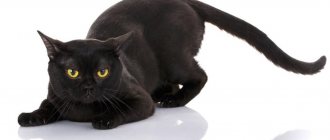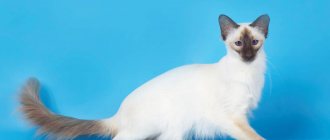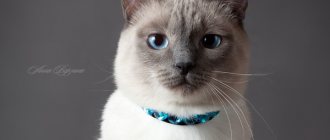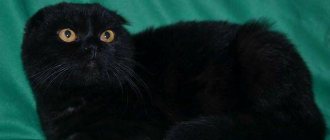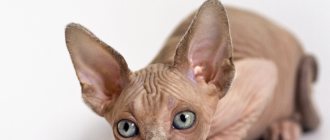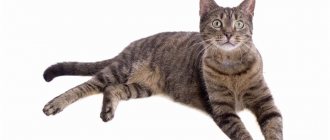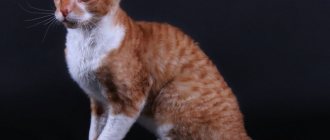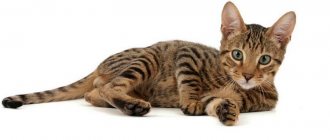The black Bombay cat has nothing to do with the ancient Indian city. She looks like a mini-panther, and owes her appearance to the crossing of two breeds - the Burmese and the American Shorthair. For superstitious people, this cat personifies something terrible, since its color from the tip of its nose to the pads on its paws is jet black. It is worth mentioning separately about the coat of the Bombay cat - its smoothness, shine and density, as well as its impenetrable ink color, are more reminiscent of patent leather than just short hair.
Americans even call representatives of the Bombay breed “shoe polish beauties with eyes like shiny copper coins.” Our compatriots, seeing this cat, will most likely exclaim in admiration: “Bagheera!”
Origin of the Bombays
The first to develop the Bombay breed was an American breeder from Louisville (Kentucky) named Nicky Horner. Her goal was to create a “miniature panther.” To do this, she crossed the sable Burmese and the American Shorthair, which has a solid black color. The first results of selection appeared in the late fifties, but they were not successful. But after several years of working with different breeding samples, things started to improve. The result was a cat with excellent muscles and a short, smooth-lying, black “fur coat”.
Over the next 18 years, the breed gradually became recognized. In 1976, Bombay were admitted to the CFA Championship.
Bombay breeders often reuse Burmese for mating to preserve the structure of the coat and constitution. As a result, there is a similarity between Bombay and Burma. Breeder Nikki Horner is inclined to believe that the Bombay breed is the Black Burmese. But many breeders note some differences. For example, Bombays are somewhat larger, have longer bodies and legs than Burmese, and also have a less pronounced nose break.
There is an opinion among breed connoisseurs that when a person wants to have a cat, a dog and a monkey, then he wants to get a Bombay. These animals can walk perfectly on a leash, usually love games, and are always trying to invent new games to entertain themselves and their owners. Bombays have an excellent appetite; they love to eat hearty and tasty food. These are friendly cats, with high intelligence, capable of becoming excellent companions. They are loyal to children and get along well with other pets, including dogs. In Bombay, prudence is combined with calm. Moreover, the first quality is typical for the American Shorthair, for the inquisitive Burmese.
Bombay cat breed description
The cat's body is medium, strong and compact.
The coat is smooth and shiny, it should always be short and jet black in color.
Round head, without corners or protrusions. The chin is strong and the muzzle is short. Wide-set and slightly tilted forward, as if alert, ears with rounded ends. Round eyes can range in color from gold to copper. The nose has a pronounced break, but without snubness.
Those Bombays are subject to disqualification if there are spots or marks on their skin, or if their paw pads or nose are not black. A green tint to the eyes is considered unsuitable, as is an overly pronounced stop, which can make breathing difficult and sniffling observed. For Bombay cats, a perfect bite and a certain number of toes are required. Tail defects are also considered reasons for disqualification. If the animal’s muscles are weak, it is too heavy, or rough, then a fine is imposed. Judging by the exhibition samples, the quality and shade of the wool makes 55% of the assessment of Bombays.
Bombay is considered an unusual cat. To increase the number of these amazing animals, many breeders are uniting.
Standard and description of the breed.
Completely black “anthracite”, right down to the nose and pads on the paws - this is a Bombay cat. Her short fur coat lies tightly on her body. At the same time, it is shiny and so alive that it can be mistaken for patent leather. Thanks to the shimmering depth of black coat and golden or copper eyes, this cat is mesmerizingly beautiful.
Interesting Facts
Any owner of a Himalayan cat will definitely tell you about their pet that:
- The gene responsible for the “Siamese” color is recessive. For the offspring to have this coloration, both parents must have a color-point coat.
- The blue tint of the eyes in cats of this breed is due to the low level of melanin in the cells of the iris.
- These animals are called "Himalayan" because of the similarity in color to the rabbits of the same name, bred in 1857.
- Cats of this breed have another alternative nickname - Persian color point.
Care and maintenance
The Bombay requires grooming to keep its coat sparkling clean. The first molt can be observed at about one year of age. At this time, the downy brownish coat, which does not have an undercoat, must be combed out with a brush. And, even if the animal seems “undressed” for some time, then pretty soon it will grow new hair. Combing with a special brush is carried out weekly, and during the molting period this will have to be done more often. After brushing the cat, you need to run a damp hand over its body to collect individual fallen hairs. To add shine, the cat's fur coat is “polished” with suede cloth.
These cats are not great lovers of water, so bathing them is not recommended. It is enough to do this once every six months. The shampoo must be chosen so that it matches the type of coat, otherwise the cat may develop dandruff and irritation, and the coat may become dull.
Claws should be trimmed as they grow, but for cats that actively use a scratching post, this procedure is not necessary.
The cat's ears and eyes should be examined regularly; any contamination found should be wiped with a slightly damp cotton swab. If there is unusual discharge from the eyes, you should immediately contact your veterinarian for treatment. Since gum problems are not uncommon for Bombays, you need to pay special attention to the oral cavity, remembering to regularly brush your pet’s teeth with a special brush and paste.
A pleasant bonus of this breed is its cleanliness. If the cat's litter box is washed in a timely manner and the filler in it is changed, then there will be no unpleasant odors. Veterinary pharmacies sell special sprays that quickly deal with the unpleasant odor.
Also, do not forget about the necessary vaccination of the animal and prevention against worms.
In order for the functioning of the gastrointestinal tract to be well-functioning, the cat should be given only balanced food, and in no case should it be overfed, even if it is trying to “hypnotize” you with its gaze with the most hungry look. High-quality dry professional food is preferable. For adherents of “natural” it is necessary to control the balance of nutrients, vitamins and minerals. For animals prone to obesity, this is especially important.
Bombays' diet may include: turkey or chicken, lean boiled meat and offal. Periodically, but not often, the cat is given a boiled egg yolk. For kittens, porridge made from oatmeal and buckwheat is useful. At the same time, river fish, salted and smoked foods from the owners’ table are absolutely prohibited.
In winter, the cat especially needs vitamins, so it is recommended to give it fish oil capsules. It contains OMEGA-3, thanks to which the cat will not suffer from dry skin, and its coat will become shiny and strong.
For Bombays, a sense of absolute security is important, especially when they are sleeping or just relaxing. Therefore, the cat’s sleeping place should be arranged in the most secluded place where it will be calm. The animal needs to be provided with a sufficiently large bedding, since these cats do not sleep in the usual way, like their counterparts - curled up in a ball, but stretched out to their full length. At the same time, it is of great importance for a cat to be close to members of the household, which means that the bed needs to be placed in a place where the pet can not only rest, but also comfortably observe everything that is happening around.
The excessive activity of cats of this breed indicates that they simply need a sufficient number of different toys and “entertainment”. Otherwise, bored alone, the Bombay cat will easily start playing with any object that comes into its paws.
Bombays are very thermophilic, so the temperature in the apartment must be strictly defined. If there is a draft in the rooms, the cat may catch a cold.
Thanks to its fairly developed intelligence, it is not difficult for a Bombay cat to get used to a litter box, walking on a harness, as well as various hygiene procedures, such as combing and bathing. Already from childhood, the cat must be accustomed to the place where it will sleep (it should be quite spacious and without drafts), and also behave correctly - not climb on the table and, especially, not carry food from there.
Bombays are passionate about pleasing their owners, so they learn quite quickly. Performing simple tricks is easy for them and even gives them pleasure. For example, when following commands, they can stand on their hind legs, make a voice, jump over an obstacle, or bring a toy in their teeth. If the owner plans to train a cat, then this should be done starting from an early age, reinforcing commands with affection or treats. If a cat is forced to perform tricks or raised his voice at her, then she may refuse to perform them forever.
How to choose the right kitten
To avoid being deceived, it is advisable to buy a Himalayan kitten from trusted breeders or certified nurseries. Before concluding a transaction, you must make sure that you have a veterinary passport with vaccination marks and documents confirming your breed.
It is also advisable to pay attention to the behavior and living conditions of small Himalayans. Kittens should be inquisitive and playful. And the room where the Himalayans live should be warm, light and clean.
It is important that kittens do not have fleas, bald spots, scratching, unpleasant odor from the mouth and dirt under the tail. Healthy Himalayans should have a soft coat and clean eyes and ears.
Kitten care
Himalayan kittens from good nurseries go to new homes no earlier than they are 12 weeks old. By this point, they are already eating a variety of foods on their own, know how to use a litter box, and are accustomed to a scratching post. Therefore, the owners only need to wait until the little Himalayan gets comfortable in the new place and show him where he can eat and relieve himself.
Owners must take care of the kitten's safety in advance. To ensure that the Himalayan does not suffer from his own curiosity, large equipment and windows are covered from him, and household chemicals, small items, indoor plants and wires are also hidden.
To prevent the kitten from developing digestive problems amid the stress associated with the move, at first it is fed what it is accustomed to. New foods are introduced into the little Himalayan’s diet gradually to monitor the body’s reaction. The feeding schedule is based on the age of the kitten:
- up to 12 weeks – 5-6 times a day;
- 3-6 months – 4 times a day;
- 6-12 months – 3 times a day.
An adult Himalayan cat is switched to twice feeding.
Bombay cat - CFA standards
The head should have a pleasant roundness, with no angles. Bombays have a fairly full muzzle. There is quite a decent gap between the eyes. It smoothly transitions into a massive, developed muzzle, maintaining the roundness of the contours of the head. The nose is slightly rounded at the bottom
The eye shape is round. The ears should be of medium size and spaced farther apart, and a slight forward tilt is encouraged. Their base should be wide and the tips slightly rounded.
The chin should not protrude, which indicates the correct bite.
With medium dimensions and good muscles, the cat should not appear lean or too compact. Large dimensions are allowed for cats.
There is only one requirement for the paws - proportionality to their tail and body. The round ends of the paws should have five toes at the front and four at the back.
A straight tail of medium length should not be short.
The coat ideally has a satin texture, is short and lies fairly close to the body. It is characterized by a shiny shimmer, reminiscent of leather with a varnish coating.
Disadvantages include too short or, conversely, elongated hair. There is an abnormal curvature of the tail, as well as an incorrect number of toes. Sometimes there are individual hairs or spots of white color. A different shade of pads on the paws and skin of the nose, except black. Green shade of eyes. Overbite and overbite may also occur.
Color options
An adult cat's coat is fully colored, right down to the base. In kittens, it acquires a darker shade and smoothness only as they grow older.
The nose and paw pads are exclusively black. Eye shade can vary from gold to copper, and the brighter and deeper it is, the better for the breed.
Habitat and role of the African black-footed cat in the ecosystem
The small black-footed cat lives in the southern regions of the African continent in deserted open dry plains, in savannas and steppes with occasional thickets of low bushes and tufts of grass.
Traces of this animal were found in the following countries:
- SOUTH AFRICA;
- Angola;
- Namibia;
- Botswana;
- Zimbabwe.
In the wild, the black-footed cat lives in the dry desert regions of Africa.
There are two types of miniature predators living in different places:
- Felis nigripes thomasi - in Botswana (sparsely inhabited areas of the Kalahari Desert), distinguished by a more contrasting and darker fur color;
- Felis nigripes nigripes - in Namibia (Karoo plateau) in dry grassy areas, individuals of this species are smaller in size and their coat is paler.
Despite their miniature size, black-footed cats are important predators, having a significant impact on the population of rodents and various small mammals.
Bombay cat - character
These are very affectionate cats.
Since the Bombay cat was bred by crossing a Burmese cat with an American Shorthair, which has a black color, the resulting animal has character traits from both breeds.
Based on this, the disposition of Bombay cats is a certain differential of calm and poise, characteristic of short-haired “Americans,” with the playfulness and sociability of Burmese.
The orientation towards people of Bombay cats is simply amazing - they, like the Burmese, are insanely devoted to their owner, but, at the same time, they are not inclined to harass him with constant demands for “talking”, as American Shorthairs do.
True connoisseurs of this cat breed are sure that Bombays can easily win the heart of absolutely any person, even if he has never noticed a special love for cats in himself. He will not be able to remain indifferent to the magnificent combination of glossy black fur and the hypnotic gaze of copper eyes. And, considering that a pleasant personality is also attached to all this, it is almost impossible to resist.
Of course, deep down, Bombays crave attention from their owners, which is why they try to accompany them everywhere, like little black shadows. They always have a desire to be the center of attention and take a place on their master's lap. If you are one of the people for whom the constant presence of a cat nearby is undesirable, then you should think about choosing a different breed.
Guess which member of the household will be the first to welcome guests! Of course it will be a Bombay cat, because she is completely sure that the guests have come to her.
This cat is considered “sweet” and gentle, she will gladly accept any offer. Especially if it concerns the game. Such a pet does not choose one person from the family to give him his love - he adores the whole family. Animals of this breed are curious, playful and quite active.
Those who know this breed well claim that Bombay cats, despite some wariness towards children, can still find a common language with them. But most importantly, this is one of the few cat breeds that get along quite well with dogs.
Photo gallery: wild African black-footed cat
A black-footed cat can catch a bird when it flies low above him.
Blackfoot hiding in the bush
Black-footed cats retain their wild nature in captivity
The black-footed cat mercilessly expels strangers from its territory
At the slightest danger, the kittens hide and wait for their mother. In the summer, the black-footed cat has a very bright and contrasting color
The black-footed cat sleeps curled up in a ball, like most representatives of the cat tribe
The dry desert regions of Africa are the natural habitat of black-footed cats.
The black-footed African wild cat looks unusually sweet, but in this case, appearances are extremely deceptive. The little animal is a desperate and brave hunter who needs to live only in natural habitats, that is where he will be most comfortable.
Diseases
Bombays may suffer from various diseases. For example, heart defects with genetic determination, defects in the structure of the skull and spinal canal. By the way, many bloodlines have a deformation of the skull. A common defect is difficulty breathing through the nose, which is a consequence of the stop being too pronounced for this breed.
Bombay cats are generally in good health, and if cared for properly, they can live up to 20 years. In addition to cardiomyopathy (enlarged walls of the ventricles), problems with breathing and gums, they may experience obesity due to too good an appetite, or a disorder of the digestive system.
To understand that a cat has a heart disease, it is enough to notice that it is drowsy, breathes quickly, has a rapid heartbeat, and sometimes faints. If such signs occur, you should immediately consult a doctor. If treatment is started on time, the animal’s condition can be significantly alleviated and its life extended.
The specific structure of the cat's nose is such that Bombays often have runny noses and lacrimation. On the advice of a veterinarian, the nose can be washed with a special solution, and the eyes can be instilled with drops.
Diet
The small predator feeds on small animals, gerbils, shrews, as well as small birds, insects and reptiles. Enjoy eating eggs. In the excitement of the hunt, the cat does not stop even in front of a prey that is twice its own size. Breakfast can be a hare or a black bustard. The thrifty animal does not throw away the uneaten leftovers, puts them in a hole, and then returns to them.
The black-footed cat has very high energy needs. During the night she kills about 14 small animals and eats approximately 250 g of a variety of food, which is 1/6 of her body weight.

